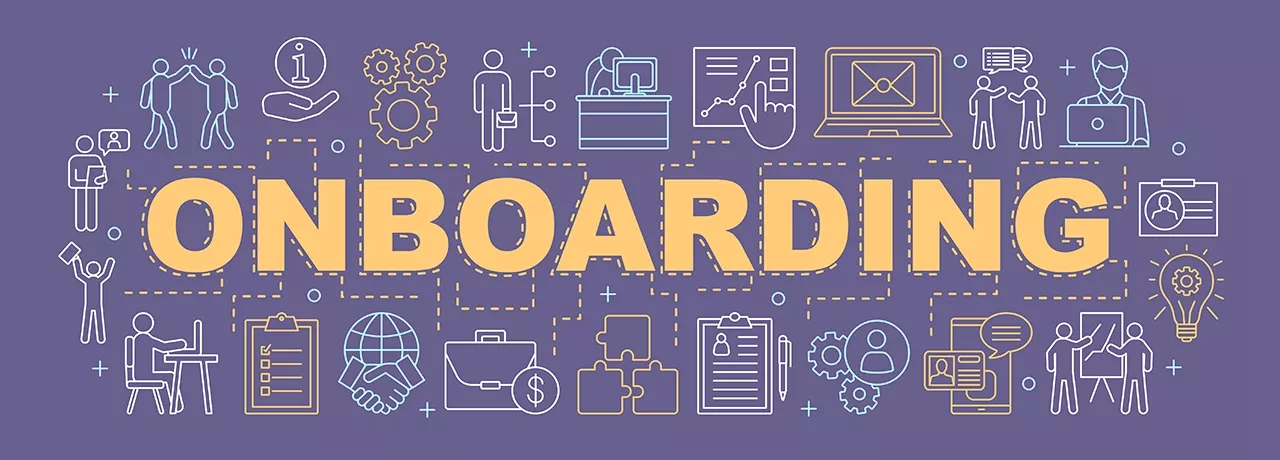
Orientation vs. Onboarding: Important Differences
January 11, 2023
By Terri Moore
Orientation and onboarding can make or break the new hire experience — and drive long-term loyalty (or send employees running). But, while the two terms are often used interchangeably, they are not the same. They are, though, both integral parts of a company’s employee engagement and retention strategy.
An employee’s experience with your company starts from the moment of their first touchpoint with your company, be it your website, the interview process, or a social post. But, once they’ve accepted the job, they’re committed. You want to reward that commitment by making sure your new employee feels welcomed and that every experience from that point on reinforces their decision to join your company.
Orientation and Onboarding: Definitions
As the terms themselves convey, orientation is about orienting the employee to the job while onboarding is about getting the employee on board and ready to be productive and engaged.
Orientation generally involves the administrative aspects of getting the new employee started — filling out required paperwork for payroll and benefits administration, sharing company policies and procedures, and explaining how their position fits into the company’s short- and long-term goals. Some organizations stop right here and feel they have successfully oriented and onboarded the new employee. They haven’t.
Onboarding goes beyond the administrative elements of orientation and encompasses a process that involves training and additional, hands-on acclimation to their work and the people they will be working with. It’s a process that can take weeks, even months in some organizations and roles.
As the Society for Human Resource Management (SHRM) tells us: “While orientation is necessary for completing paperwork and other routine tasks, onboarding is a comprehensive process involving management and other employees and can last up to 12 months.”
The time spent here is well worth the investment — for both new employees and the company. Employees who feel valued and connected to the company’s “why” are more engaged, more productive, and more loyal. The proof? ServiceNow reports when the onboarding experience is not positive, new hires are twice as likely to quit their job compared to those who have a good onboarding experience.
To summarize: orientation introduces employees to the company and its policies and practices, while onboarding is a broader and more in-depth process designed to help the new hire become acclimated to the company, their new role, and their colleagues. Both are important but, as we’ve seen, they serve different purposes.
Ensuring Onboarding Efforts are Effective
The onboarding process is a critical stage in talent acquisition and the success of the company and its culture. It’s a process that requires careful planning and ongoing evaluation and modification to ensure that it meets the needs of both the organization and the employee. During onboarding:
Employees want to develop a thorough understanding of what their jobs will entail, who they will be working with, and how they can positively contribute.
Employers want to ensure that employees start off on the right foot armed with the information and access to resources that will contribute to their success and long-term tenure with the organization.
Getting it right during the onboarding process gets employees aligned with organizational values and, when done well, supports the decision they made to join the company, contributing to higher retention rates. According to Glassdoor: “Employees who rated their onboarding experience as ‘highly effective’ were 18 times more likely to feel highly committed to their organization.”
Some critical things to keep in mind during onboarding:
- Be ready for the new employee and ensure that others in the organization have been briefed about them and their new role
- Set up a buddy system so the new employee has someone (other than their direct manager) to turn to for information and assistance
- Introduce employees to the organization’s mission and values
- Emphasize professional development efforts and opportunities
- Provide employees with training on how to recognize other employees
Building trust through communication during onboarding begins the employee’s life cycle with the company positively, setting the stage for future interactions and long-term engagement.
During the onboarding process, it’s important for employees to meet and have time to interact with company leaders, their managers, their colleagues, and others. This can take place formally or informally and, as we learned during the pandemic, can be done on-site, remotely, or in a hybrid manner.
Again this is not a one-time initiative or event. Helping employees make and maintain connections is an ongoing part of the employee experience.
Making — and Maintaining — Important Connections
While some companies have onboarding processes that can go on for weeks, at some point in all companies the onboarding process is completed. That doesn’t mean, though, that the important elements of the onboarding process — making the employee feel a sense of belonging and that what they do matters — ends. If you are looking for ongoing ways for how to improve team culture, this is it!
It’s important that once the relationship has been established, it’s maintained over time to ensure the employee remains engaged, productive, and loyal.
Tools like Inspirus Connects can help do this — from orientation and onboarding through the entire employee experience. The technology helps introduce the new employee to the company, fosters a sense of belonging, exposes the employee to new faces and facilitates introductions. Once onboard, though, Connects continues to serve as an important resource and conduit to others in the organization and provides an opportunity for ongoing feedback and support.
Spotlights, a feature of Connects, is a great way to ensure that new employees learn about company-wide initiatives, updates, and news. It can also provide a platform for informing employees about community service projects, company-wide challenges, and training and development opportunities.
Orientation and onboarding should be an integral part of your holistic employee engagement strategy. While serving different purposes, together they establish the foundation for building a more productive and more loyal workforce.




